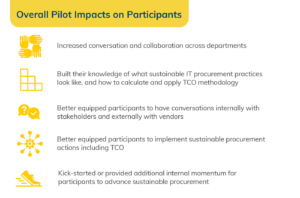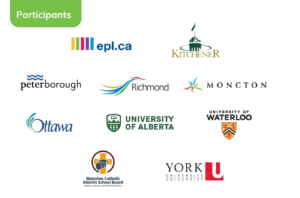Advancing Sustainable Procurement in Canada

Projects Sponsor
Purchases made by the Canadian public sector make up 13% of Canada’s GDP, and yet, most Requests For Proposals (RFPs) don’t consider sustainability as a critical factor in buying decisions.
To address this, Green Economy Canada led a sustainable IT procurement pilot with ten public sector organizations. This pilot helped to identify success factors and key barriers to advancing sustainable procurement. Ultimately, the project led to the creation of free tools and resources and an eight step process that other organizations across Canada can implement to have an impact. Green Economy Canada’s project shows how organizations can use their purchasing power to create a better future.
Faced as we are with ever-growing social and environmental challenges, it is vital that organizations revisit their business models and innovate to build more resilient and sustainable supply chains. With their enormous buying power, Canadian public sector organizations play a unique role in accelerating the climate action needed to encourage the market transformation towards a decarbonized, circular economy. These organizations have the power to reduce waste, eliminate inequalities, tackle the climate emergency, and address biodiversity loss by simply shifting the way they buy. It’s a power many of them aren’t using because many of us monitor whether our businesses and organizations are in the black, or the red, but aren’t taught how to become green.
 In today’s linear economy, buyers prioritize the lowest price on goods and services while limiting or omitting sustainability criteria in bid documents. Suppliers naturally respond by providing products that are typically less repairable or recyclable, are made with cheaper or unsustainable materials, and have shorter lifespans. Manufacturers do this, in the service of delivering the lowest price to win the contract. We have a climate disaster on order.
In today’s linear economy, buyers prioritize the lowest price on goods and services while limiting or omitting sustainability criteria in bid documents. Suppliers naturally respond by providing products that are typically less repairable or recyclable, are made with cheaper or unsustainable materials, and have shorter lifespans. Manufacturers do this, in the service of delivering the lowest price to win the contract. We have a climate disaster on order.
Recognizing the urgent need to change that, Green Economy Canada, a national non-profit working to accelerate Canada’s transition to an inclusive net-zero future, led a pilot project. Supported by HP Canada, the project focused on identifying and improving sustainable IT procurement practices. Their goal was to help public sector organizations leverage procurement power toward a sustainable future.
The pilot spanned eighteen months with ten broader public sector organizations participating nationwide. As a first step, all participants were asked to complete a Sustainable IT Self-Assessment to evaluate their baseline sustainable procurement performance. The aggregated results were shared with participants to highlight areas of strength and opportunities for improvement relative to their peers, as well as to understand trends across all participants. The results of the self-assessment informed all parties about the important sustainable IT standards and measures to begin evaluating.

To support clear signalling that sustainability was valued in the marketplace, the pilot focused on two important sustainable procurement aspects conducted in two phases. The first focus area was on impacting the Request For Proposal (RFP) process through the meaningful inclusion of sustainability criteria as part of vendor evaluation. The second aspect focused on determining the best value for money by applying the concept of Total Cost of Ownership (TCO).
Along with their peers and experts in the field, participants attended a variety of workshops, including an introduction to the circular economy and assessing sustainable IT procurement practices. These workshops served to build the participants’ knowledge and empower them to use it. Manageable steps were laid out to help participants begin embedding sustainable practices in their organization. These included developing policies to support sustainable procurement and building the necessary internal organizational relationships to be successful.

The workshops provided an opportunity for participants to discuss successes and challenges, ask questions of experts, and build connections with peers working on advancing sustainable procurement. Participants were supported to make progress outside of workshops through one-on-one check-ins and plug-and-play templates and resources. Participants were also surveyed regularly throughout the pilot to capture their experiences in real-time and a more in-depth survey was conducted at the conclusion of the major phases of the pilot. The responses collected from these surveys, the self-assessment, and the many one-on-one meetings, informed the project’s white paper: Buying A Better Future – Insights from a Sustainable IT Procurement Pilot.
The white paper includes a list of major barriers to implementing sustainable procurement practices, suggestions for ways to overcome them, and insights into the key success factors for integrating sustainable procurement. It also provides tools and resources at no cost. The white paper and resources can be found at: https://greeneconomy.ca/sustainable-it-procurement/.
The Sustainable IT Procurement Pilot designed and led by Green Economy Canada demonstrated how a group of public sector organizations could harness the power of procurement to drive action on sustainability in the marketplace and get the best value for money. Imagine what would be possible if all organizations in Canada used their purchasing power to do the same.













